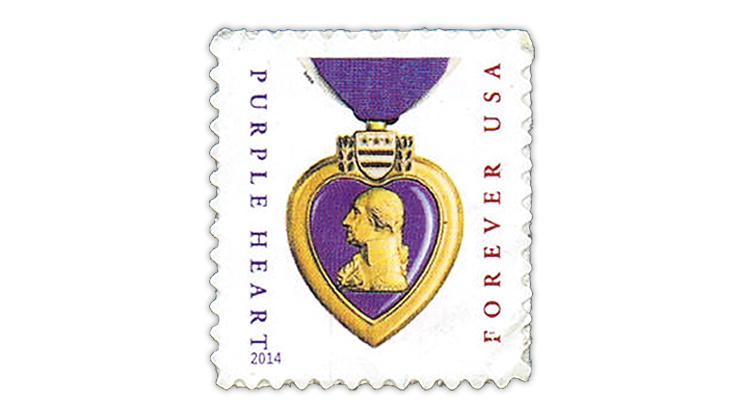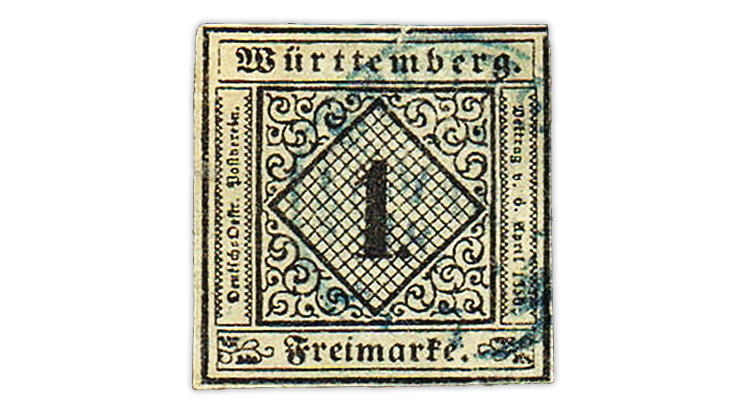US Stamps
Self-adhesive stamps provoke questions that may not have clear answers
U.S. Stamp Notes by John M. Hotchner
Linn’s readers are the best. The questions you come up with are often unexpected and thought-provoking. Witness this question from Richard H. Joy, of Oxford, Conn.:
“If a self-adhesive stamp were removed from a pane or booklet and mounted on another piece of USPS (or similar) backing paper to put in an album, would it still be considered mint-never hinged (M/NH)?
“If no, end of story. If yes, then should the stamp condition be reflected on certificates to include being ‘on original backing paper’ if it is?”
Leaving aside that it might be impossible to tell whether the backing paper attached to the stamp is original or not, I would propose that a stamp is mint, never-hinged if its gum is present in perfect condition.
Given that a stamp can be removed from backing paper and maintain that condition, the backing paper can be thought of as immaterial to the mint, never-hinged status of the stamp.
But unless you intend to stand there holding the stamp between your thumb and forefinger for all eternity, something must be done with it. Either the stamp gets used, or it must be put back on the original backing paper, or on different paper.
The quality of that paper is critical. Once stuck on paper from which it can’t be removed without damaging the gum, the stamp should no longer be considered mint, never-hinged because it can’t be proven to be so.
Thus, to me, it does not matter whether the backing on a mint, never-hinged stamp is original. It only matters that the stamp can be cleanly peeled off the backing to demonstrate the perfection of the gum.
Of course, the more often that is done, the less likely the stamp is to adhere completely to the original high-gloss backing or a substitute.
I have a related question that presents a slightly different perspective: What about self-adhesive stamps that have been on backing paper for so long that attempts to remove them seem doomed to failure?
A percentage of older United States self-adhesive Purple Heart stamps, such as the example dated “2014” (Scott 4704b) that is shown in Figure 1, and some others seemingly can’t be separated from their backing paper.
Attempts to do so leave varying amounts of backing paper layers stuck to the stamp. I have had to use a glue stick to get these perfectly valid unused stamps to adhere to an envelope to prepay the postage.
Do we take as fact that such stamps are mint, never-hinged when the backing is undisturbed but they can’t be separated cleanly from their original backing?
All of this may have a certain “How many angels can fit on the head of a pin?” quality to it.
But they are real questions that presumably could have implications for the collectibility and value of self-adhesive stamps as we proceed into the future.
I don’t pretend to have the final answers, nor can I resolve the questions on how to reflect the status of such material on expertizing certificates.
Because we are talking about modern material when discussing self-adhesive stamps, we might not have a pressing need to answer these questions in the immediate future, but we ought to get started thinking about how to handle these matters.
Multiple certificates; multiple opinions
The Kingdom of Wurttemberg issued its first stamps in 1851. Figure 2 shows one of its early stamps.
Linn’s reader Bruce Wright wrote in with the following problem about a stamp from Wurttemberg (not the example shown in Figure 2): “I collect color shades, perforation types, watermark varieties, etc., of Germany; old states through modern. I normally get a certificate on any stamp cataloging €100 or more. Not only does this mean that I have a properly identified item, but it will make matters much easier when I reach the point when it is time to dispose of the collection.
“About a third of my auction purchases come back with judgments that the auction house misdescribed the lot. Because of the way I collect, especially with color shades, the differences can be subtle. And, since any certificate is based on a subjective evaluation, in some cases it has resulted in a high degree of frustration.
“I have one Wurttemberg stamp that has three certificates. Certificate 1 says it is a beautiful copy of the rare shade b with partial original gum and a rare plate flaw. Certificate 2 says it is a reprint (no shade mentioned) with a plate flaw and has been regummed. Certificate 3 calls the stamp a reprint of common shade a, with partial original gum and a hinge remnant, with no mention of the plate flaw. So, what is it? Do I get to choose? Very frustrating, since the point of a certificate is to provide clarity and certainty.
“In spite of these molar grinding examples, I firmly believe in the value of certificates for any expensive stamp to achieve peace of mind that you really have what you believe you are purchasing!”
To some extent, yes, the requestor does indeed get to choose — but with some caveats.
Do all three certificates come from the same expertizing authority? If so, then the last opinion is generally the one that should be favored.
The reason is that the more recent the opinion, the more science is likely to have been applied to reaching the conclusion, and the prior findings would have been considered in reaching it.
But, while current opinions are generally favored over older opinions, individual experts can differ in their level of competence, and today’s expert might not have the experience of one who is retired.
It is undeniable that some of the experts of yesteryear were walking encyclopedias whose knowledge and opinions could rarely be challenged. Add to the mix that different expertizing authorities can have varying reputations for the accuracy of their opinions, both in general and for specific areas of inquiry.
So for the owner of the Wurttemberg stamp with three certificates that don’t match, it is not just a matter of picking the one he likes best.
If there is a premier recognized authority for the class of material being expertized, then that is the one that should be given preference.
In a sense, however, it does not much matter what the owner picks. By the time a certificate is several years old, the auctioneer or the buyer considering the stamp may have a preferred expertizing authority.
And on something that could be controversial, there is little doubt that either the auctioneer or the buyer will want to get a current certificate before completing a purchase.
Expertizers will make the evaluation as objectively as they can, but expertizing is as much an art as a science. So, the new opinion could be any of the three described, or yet a fourth version.
As much as we might wish that the expertizing process could be relied upon 100 percent, it is a human effort, and we are not perfect. Understanding the pitfalls is important for both submitters and expertizers.
Fortunately, the vast majority of items being expertized do not have the level of subtlety that lends itself to varying opinions. Thus, the number of items in that class is statistically small.
But every one will leave frustration in its wake — especially when a positive opinion is reversed or matters determined by one certificate are ignored by a subsequent effort.
Thanks to all Linn’s readers who respond to these columns on expertizing.
Connect with Linn’s Stamp News:
Sign up for our newsletter
Like us on Facebook
Follow us on Twitter
MORE RELATED ARTICLES
Headlines
-
US Stamps
Oct 7, 2024, 3 PMMcMurtrie dismissed as APS education director following Sept. 21 arrest
-
US Stamps
Oct 7, 2024, 12 PMVasiliauskas named president of Mystic Stamp Co.
-
US Stamps
Oct 6, 2024, 5 PMApgar souvenir card available
-
US Stamps
Oct 6, 2024, 4 PMFirst Continental Congress and U.N. stamps receive Scott catalog numbers










